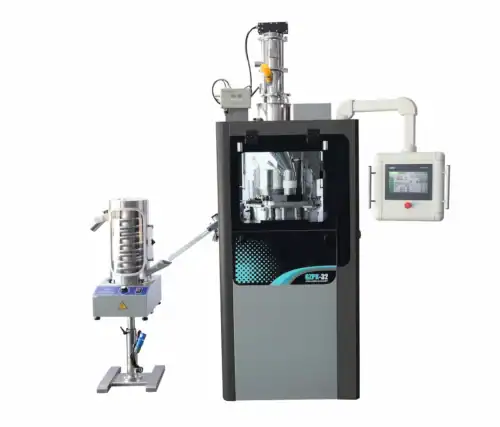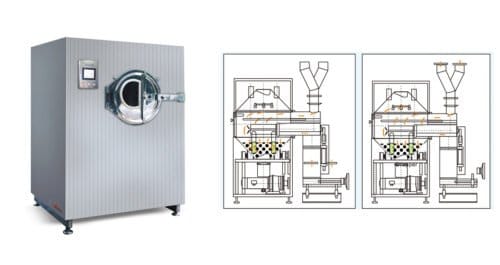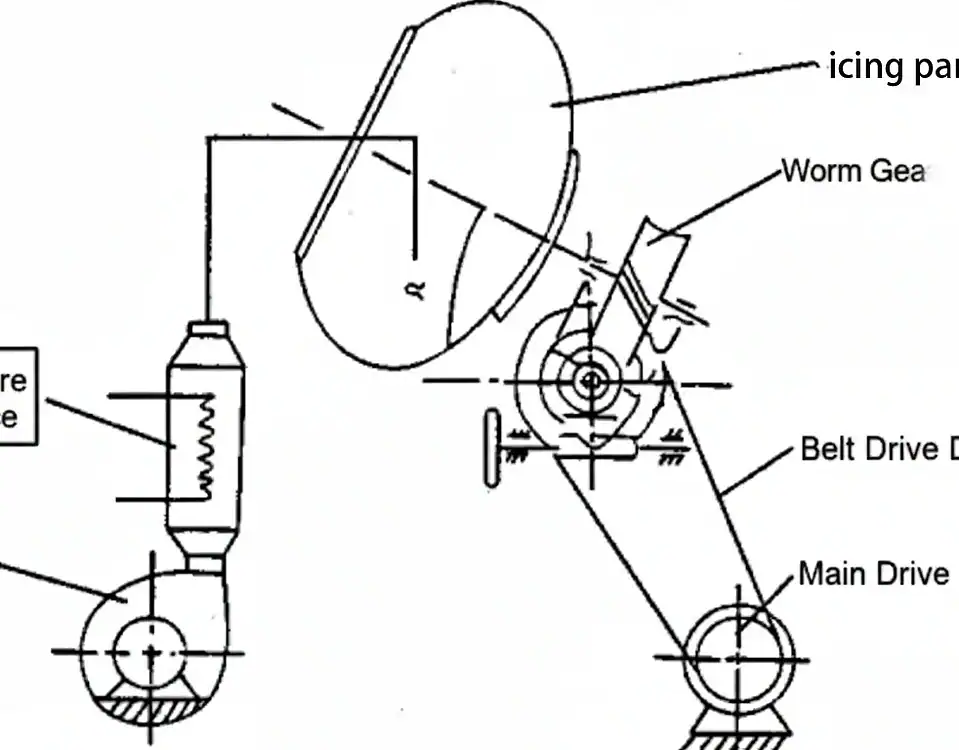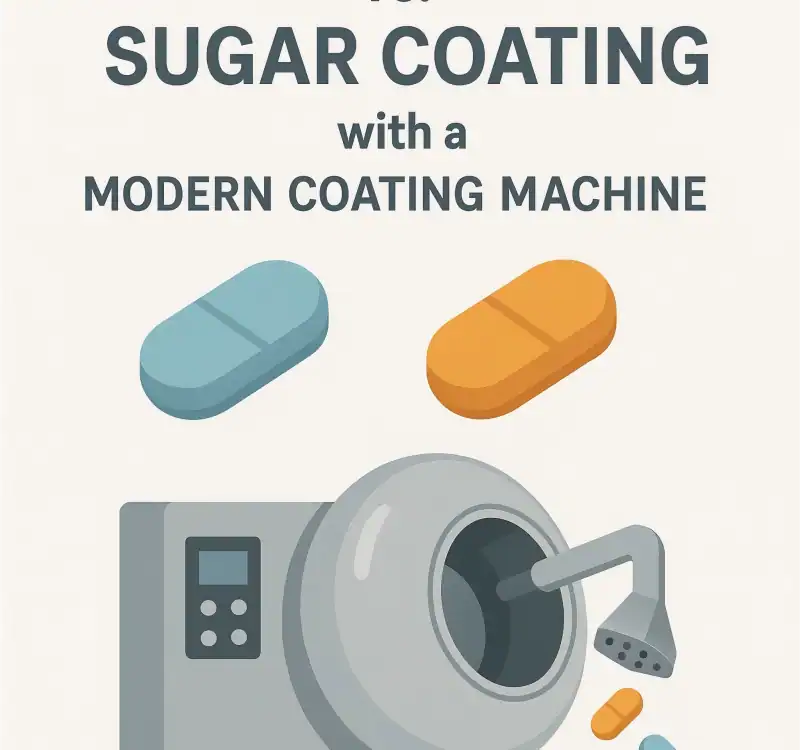
Grand Ternary vs Circular Swing Screening Machines – Comparison & Guide

Grand Horizontal Labeling Machine Features – Grand Solutions
What is Enteric Coating? — Benefits, Uses & Coating Equipment
Enteric coating is a specialized polymer film applied to pills and tablets to protect them from the acidic environment of the stomach. An enteric coating remains intact at low pH in the stomach and only dissolves when it reaches the higher pH of the intestines. In other words, “enteric” means relating to the intestine, and the coating delays drug release until the medication passes through the stomach. This approach is common in oral pharmaceuticals and supplements because it can shield acid-sensitive drugs from stomach acid and prevent stomach irritation from harsh medicines.

Key benefits of enteric coatings include:
Drug protection: Shields the medication’s active ingredients from acidic degradation in the stomach. This is vital for drugs (or nutrients) that are unstable at low pH.
Targeted release: Ensures the drug is released only in the intestine, often improving absorption and effectiveness.
Gastroprotection: Prevents irritation of the stomach lining. For example, enteric-coated NSAIDs (pain relievers) keep aspirin or ibuprofen from dissolving in the stomach, reducing the risk of ulcers.
Masking taste: The coating can mask unpleasant tastes or odors, making pills easier to swallow.
Vegetarian-friendly options: Modern enteric coatings can be made from plant-based polymers (like HPMC/HPMCP) suitable for vegetarian capsules.
Many over-the-counter and prescription medications are enteric-coated. Common examples include: aspirin or ibuprofen (to avoid stomach upset), proton-pump inhibitors like omeprazole (to protect the drug until it reaches the small intestine)verywellhealth.compubmed.ncbi.nlm.nih.gov, and certain digestive enzyme or probiotic supplements (so the enzymes/bacteria survive stomach acid). Enteric-coated vitamins or supplements (e.g. folic acid tablets) are also available in some cases. When reading labels, you might see “EC” (enteric-coated) appended to a drug name (for example, omeprazole EC).
How Enteric Coatings Work
Enteric coatings are made of pH-sensitive polymers (often cellulose derivatives or acrylic resins) that are insoluble at low pH but dissolve at higher pH. In practice, a tablet with an enteric coat is swallowed intact. In the stomach’s acidic pH (~1.5–3.0), the coating remains solid and does not release the drug. Once the tablet moves into the small intestine (pH ~6–7), the coating dissolves, and the drug is released for absorption. This delay can range from 30 minutes up to several hours, depending on stomach emptying and food contenten.wikipedia.org.
Many enteric coatings use synthetic or natural polymers. For example, hydroxypropyl methylcellulose phthalate (HPMCP) is a common polymer: it resists stomach acid and dissolves in alkaline intestine conditions. Traditional materials like shellac or fatty acids have been used, but modern coatings often use polymer solutions to provide a uniform film. Because these coatings only dissolve at a higher pH, they effectively target drug release past the stomach. This precision makes enteric coatings a key tool for controlled-release and gastro-resistant drug products.
Benefits of Enteric Coating
Protects the drug and the patient. By keeping the drug capsule intact in the stomach, enteric coatings prevent premature drug breakdown and shield the stomach from irritation. For instance, coating aspirin or potassium chloride tablets helps avoid gastric mucosal damage.
Improves drug effectiveness. Some drugs (and even nutrients) are inactivated by stomach acid. Enteric coatings ensure these substances arrive in the intestine where they can dissolve and be absorbed. Research shows that enteric coating can increase the bioavailability of acid-labile drugs by preventing them from being degraded in the stomach.
Enables targeted delivery. Enteric coatings allow medications to be released at specific sites in the GI tract. This can be important for drugs that need to act in the intestine or colon (e.g., certain steroid medications for Crohn’s or ulcerative colitis), or for delivering probiotics and nutrients to the gut.
Reduces side effects. By avoiding drug release in the stomach, enteric-coated pills often cause fewer gastrointestinal side effects (like nausea or ulcers) compared to the same medication without coating. This is why many long-term NSAID or aspirin therapies use enteric-coated formulations.
Increased product appeal. The coating can give tablets a smooth, polished appearance and prevent unpleasant tastes. This can improve patient compliance (people prefer swallowing a smooth coating vs. a bitter pill).
Common Examples and Uses
Enteric coatings are widely used in both pharmaceuticals and dietary supplements. Some illustrative examples include:
Pain relievers (NSAIDs and aspirin): Many over-the-counter pain meds have enteric-coated versions. For example, enteric-coated aspirin (often labeled EC Aspirin) helps prevent heartburn or ulcers by not dissolving until it reaches the intestine. Generic names include ibuprofen, naproxen, and diclofenac which are also offered with enteric coatings.
Heartburn drugs (PPIs): Proton-pump inhibitors like omeprazole and esomeprazole are formulated as enteric-coated tablets or capsules. These drugs can be degraded by stomach acid, so the coating ensures the medicine is released in the small intestine where it can effectively reduce acid production.
Digestive enzymes and probiotics: Supplements containing enzymes (like pancrelipase for pancreatic insufficiency) or live bacterial cultures are often given enteric coatings so that the active enzymes or bacteria survive stomach acid and reach the intestines alive.
Vitamins and Nutraceuticals: Some sensitive vitamins (e.g. certain B vitamins) or herbal extracts use enteric-coated capsules to improve absorption. Enteric-coated multivitamins are not extremely common, but some formulations exist. For example, SAMe (an antioxidant supplement) is often sold in an enteric-coated tablet to maximize absorption – it is typically recommended on an empty stomach for best effect. Always check the product label: most enteric-coated pills can be taken with or without food, but specific instructions (such as taking on an empty stomach) will be noted if needed. If a pill upsets your stomach, try taking it with a small snack.
Note: Enteric-coated tablets should always be swallowed whole. Do not chew, crush, or split them, as this destroys the coating. If you break a coated tablet, the drug will release too early and may irritate your stomach or become ineffective.
How to Take Enteric-Coated Tablets
Swallow whole with water. Always swallow enteric-coated tablets or capsules intact. Do not chew, crush, or open them. Chewing an enteric-coated pill “negates its protective effect,” exposing the stomach lining to potential irritation.
Follow timing instructions. The label should specify if timing matters. Generally, most enteric-coated pills can be taken with or without food. However, some formulations (like certain vitamins) may advise taking on an empty stomach (e.g. 1 hour before or 2 hours after eating) for optimal absorption. If unsure, ask your pharmacist or healthcare provider.
Consult for swallowing issues. If you have trouble swallowing tablets, do not break an enteric-coated pill. Instead, check if the manufacturer offers a liquid, powder, or smaller-dose option. Pharmacists can advise alternatives that preserve the delayed-release mechanism.
Check for special markings. You may see “EC” or “ENTERIC” on the label or printed on the tablet. These denote the special coating. Always review the patient information leaflet for any additional instructions.
Production and Machinery
Enteric-coated tablets are manufactured in two main stages: tablet compression and coating application.
Tablet pressing: First, the active ingredients and excipients are granulated and fed into a tablet press. Grand Machinery’s tablet press machines (e.g., rotary tablet presses like the GZPK-26 series) compress powders into solid tablets. These presses are high-speed and automated. For example, Grand’s tablet presses can produce up to 350 tablets per minutegrandpackmachine.com, and they are built for pharmaceutical and nutraceutical production. Grand explicitly notes that its presses handle “pharmaceuticals: uncoated, coated, chewable, and effervescent tablet production,” as well as “vitamin, mineral, and herbal supplement tablets”. After pressing, the plain tablets (or cores) are ready for coating.

Coating process: The uncoated tablets are then loaded into a tablet coating machine. Grand’s pharmaceutical tablet coating machine (the “Grand-B” series) uses a rotating perforated pan to tumble the tablets while spraying on the coating solution. Advanced machines like the Grand-B series are PLC-controlled with touchscreen interfaces, automating air flow, temperature, spray rate, and drum speed for precise, uniform coating. According to Grand, their coating machine “shortens coating times,” boosting productivity and product quality.

In coating an enteric formulation, the machine applies an acid-resistant polymer solution onto the tablets. Grand’s coater is versatile: it can handle aqueous (water-based), organic (solvent-based), or even sugar coatings. Importantly, the equipment is designed to meet strict standards – it has a compact, GMP-compliant design with purified air flow, and meets CE safety standards. This ensures pharmaceutical-grade hygiene. In practice, a batch of tablets can be coated with an enteric film efficiently and uniformly thanks to these advanced controls.
Grand Machinery highlights: Grand (a Zhejiang-based manufacturer) emphasizes quality and efficiency. Their tablet press and coating machines are widely used by pharmaceutical manufacturers and supplement brands around the world. For example, Grand’s machines feature reliable components (Schneider, Siemens, etc.) and full after-sales support. The company notes that its machines have passed international CE and GMP certification tests. In short, when you see a high-volume production of enteric-coated tablets or capsules, a facility might well be using equipment like Grand’s tablet presses and coaters to ensure consistent dosage and film coverage.
Summary
Enteric coatings are a key technology in drug and supplement manufacturing. By using acid-resistant polymers, manufacturers can protect medications or nutrients in the stomach and target their release to the intestines. This improves drug efficacy and patient comfort, especially for stomach-sensitive drugs. Patients should swallow enteric-coated pills whole and follow the label’s instructions on timing. In the factory, specialized machines (tablet presses and coating pans) produce these coated tablets with precision. Grand Machinery’s equipment (tablet presses and tablet coating machines) is an example of the tools used to make these products efficiently and in compliance with GMP standards.
Enteric-coated formulations—from pain relievers and heartburn drugs to specialty supplements—are an integral part of modern pharmaceutics and nutrition. By understanding how they work and how to take them properly, manufacturers and consumers alike can benefit from their targeted protection and delivery.
References
Maderuelo C., Lanao J.M., Zarzuelo A. “Enteric coating of oral solid dosage forms as a tool to improve drug bioavailability.” Eur. J. Pharm. Sci., 2019.
Verywell Health, “Enteric-Coated Medication and Its Uses.” (Online health article).
Wikipedia, “Enteric coating.” (Encyclopedia article)en.wikipedia.orgen.wikipedia.org.
Grandpackmachine, “Pharmaceutical Tablet Coating Machine.” Product pagegrandpackmachine.com
Grandpackmachine, “Tablet Press Machine For Sale.” Product page.-Grandpackmachine
Capsuline, “5 Types of Vegetarian Capsules.” (Capsule manufacturer blog).





